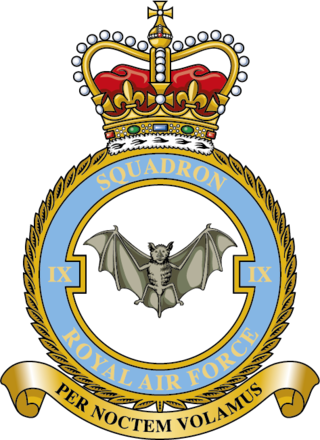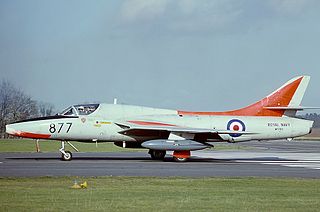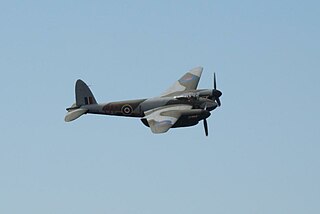Related Research Articles

Number 9 Squadron is the oldest dedicated Bomber Squadron of the Royal Air Force. Formed in December 1914, it saw service throughout the First World War, including at the Somme and Passchendaele. During the Second World War, No. IX (B) Squadron was one of two Avro Lancaster units specialising in heavy precision bombing and sank the battleship Tirpitz on 12 November 1944 in Operation Catechism. Between 1962 and April 1982, the squadron flew the Avro Vulcan B.2 as part of the V-Force. In June 1982, it became the first front-line squadron in the world to operate the Panavia Tornado GR.1. In May 1998, No. IX (B) Squadron received the RAF's first Tornado GR.4, which it operated until reequipping with the Eurofighter Typhoon FGR.4 at its present home base of RAF Lossiemouth on 1 April 2019.

The de Havilland DH.89 Dragon Rapide is a 1930s short-haul biplane airliner developed and produced by British aircraft company de Havilland. Capable of accommodating 6–8 passengers, it proved an economical and durable craft, despite its outdated plywood construction.

The Farnborough Airshow, officially the Farnborough International Airshow, is a trade exhibition for the aerospace and defence industries, where civilian and military aircraft are demonstrated to potential customers and investors. Since its first show in 1948, Farnborough has seen the debut of many famous planes, including the Vickers VC10, Concorde, the Eurofighter, the Airbus A380, and the Lockheed Martin F-35 Lightning II. At the 1958 show, the RAF's Black Arrows executed a 22-plane formation loop, setting a world record.

Peter M. Bowers was an aeronautical engineer, airplane designer, and a journalist and historian specializing in the field of aviation.

The North American Aviation T-28 Trojan is a radial-engine military trainer aircraft manufactured by North American Aviation and used by the United States Air Force and United States Navy beginning in the 1950s. Besides its use as a trainer, the T-28 was successfully employed as a counter-insurgency aircraft, primarily during the Vietnam War. It has continued in civilian use as an aerobatics and warbird performer.

The Scottish Aviation Twin Pioneer was a British STOL transport aircraft built by Scottish Aviation Limited at Prestwick Airport, Scotland, during the 1950s. It was designed for both civil and military operators. It was conceived as a twin-engined version of the Pioneer light transport. Both aircraft required "an area only 30m (99ft) by 275m (902ft) in which to operate."

Royal Air Force Bassingbourn or more simply RAF Bassingbourn is a former Royal Air Force station located in Cambridgeshire approximately 3 mi (5 km) north of Royston, Hertfordshire and 11 mi (18 km) south west of Cambridge, Cambridgeshire, England.
In aviation, a mid-air collision is an accident in which two or more aircraft come into unplanned contact during flight. Owing to the relatively high velocities involved and the likelihood of subsequent impact with the ground or sea, very severe damage or the total destruction of at least one of the aircraft usually results.
Hilaire du Berrier was an American barnstorming pilot, mercenary adventurer, journalist, and spy.
Heston Aircraft Company was a British aircraft manufacturer based at Heston Aerodrome, Middlesex, England.

The Argentine Army Aviation is the army aviation branch of the Argentine Army. Their members have the same rank insignia and titles as the rest of the Army. The Army Aviation Command is based at Campo de Mayo Military Airfield.
738 Naval Air Squadron was a Naval Air Squadron of the Royal Navy's Fleet Air Arm. It was initially active from 1943 to 1945 as a training squadron for USA aircraft types used by the Fleet Air Arm. Reformed in 1950, it continued to form part of the Fleet Air Arm training programme until its last disbandment in 1970.

758 Naval Air Squadron was a Naval Air Squadron of the Royal Navy's Fleet Air Arm. It was initially formed as a Telegraphist Air Gunner Training Squadron, from 1939 and 1941, renumbered from 759 Naval Air Squadron, operating out of RNAS Eastleigh. It moved to RNAS Arbroath, in 1940, disbanding there the following year. The squadron reformed at RNAS Donibristle, in 1942, as a Beam Approach School. Moving to RNAS Hinstock, it was known as the Naval Advanced Instrument Flying School. It provided instrument courses, utilising a large number of Oxford aircraft, with detachments sent to the specialised flying schools at RNAS Crail, RNAS East Haven, RNAS Fearn and RNAS Yeovilton. X and Y Rover Flights supplemented the detachments, Z Flight was on calibration work and evolving homing and landing capabilities, with the squadron disbanding in 1946, at RNAS Peplow, into 780 Naval Air Squadron.

759 Naval Air Squadron was a Naval Air Squadron of the Royal Navy's Fleet Air Arm. It was created on November 1st, 1939 and was disbanded on December 24, 1969. It was initially intended as a Telegraphist Air Gunner Training Squadron but became a Fighter School and Pool Squadron in 1939, at RNAS Eastleigh. It operated out of RNAS Yeovilton from 1940 to 1946, as part of the Naval Air Fighter School. In 1943 a detachment operated out of RNAS Angle, working with 794 NAS and known as the Naval Air Firing Unit. It was again the Naval Air Fighter School upon reformation in 1951 and disbandment in 1954, firstly at RNAS Culdrose and then moving to RNAS Lossiemouth, in 1953. The squadron reformed again, this time at RNAS Brawdy in 1963, as the Naval Advanced Flying Training School, before finally disbanding in 1969.

762 Naval Air Squadron was a Naval Air Squadron of the Royal Navy's Fleet Air Arm. It formed at RNAS Yeovilton in March 1942 as an Advanced Flying Training School. Almost immediately the squadron relocated to RNAS St Merryn, but before the end of the year, it was back at Yeovilton. 762 NAS disbanded nine months later.

763 Naval Air Squadron was a Naval Air Squadron of the Royal Navy's Fleet Air Arm. It formed in 1939 as the Torpedo Spotter Reconnaissance Pool No. 1, at RNAS Worthy Down. Three months later, it moved to the short-lived RNAS Jersey, before moving back to Worthy Down via RNAS Lee-on Solent and disbanding in 1940. The squadron reformed, on the seaplane carrier HMS Pegasus, as a Seaplane Training Squadron, in 1942. This role lasted around two years and the squadron continually operated and provided training from HMS Pegasus, until disbanding in 1944. Roughly two months later, the squadron reformed again, this time at RNAS Inskip, as an Anti-submarine Operational Training Squadron and remained in this role for just over one year, disbanding in July 1945 at Inskip.

The Aero Dynamics Sparrow Hawk MK II is an American homebuilt, two seater, single-engine, pusher monoplane, manufactured by Aero Dynamics Limited. It was designed by former Boeing design engineer Charles "Chuck" Herbst.
References
- ↑ The Aviation Historian magazine on Facebook
- ↑ Details at Charity Commission
- ↑ Hooks, M.J. (1981). "Recognition Contest". Air-Britain Souvenir 81. Janes Publishing Company Limited: 6.
- ↑ Simpson, Rod (2010). "Recognition Contest". Air-Britain Aviation World. 62 (3): 106. ISSN 1742-996X.
- 1 2 3 Official website
- ↑ "Aeroplane Monthly". UK: IPC Media Ltd. June 1981: 21.
{{cite journal}}: Cite journal requires|journal=(help) - 1 2 3 "Air-Britain & Aviation World". The Aviation Historian . Horsham (24): 120. Autumn 2018. ISSN 2051-7602.
- ↑ Pocketmags